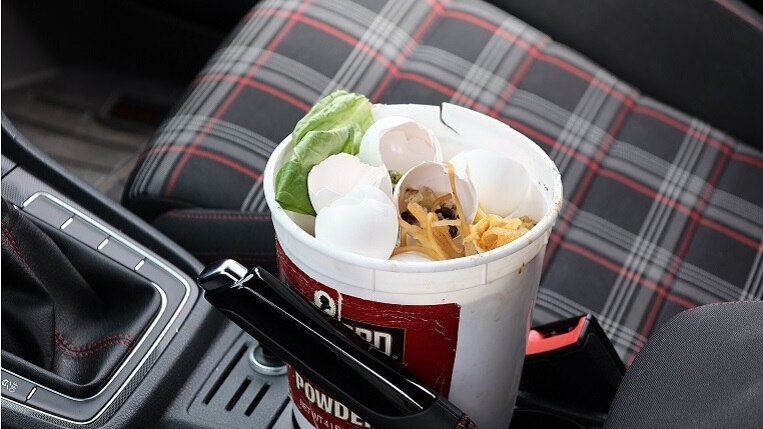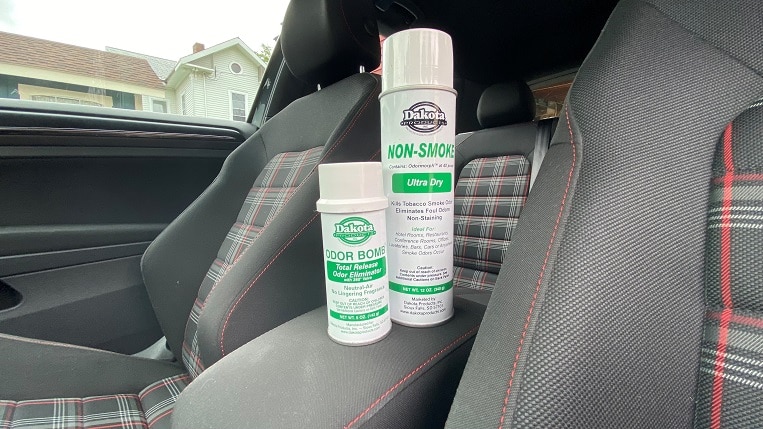Is your car starting to smell a little funky? Hanging another air freshener from the rearview mirror will only cover up the smell if you’re lucky. Adding air fresheners to the car’s interior may create a new and even more offensive smell on top of the existing pungent odor.
The smell of spoiled milk with a hint of artificial pine trees is a terrible odor.
Foul smells can come from many sources. Food, drinks, mold, smoke, pet hair, and biological fluids are the top causes of stench wafting inside your car. The good news is that there are many cleaning products and methods to remove interior odors. Remember, a vehicle should have thorough interior detail before using any odor eliminator.
People spent about 240 hours getting to work and back home in 2019, according to the Census Bureau’s average commute time data. Spending that much time in your car means there are plenty of opportunities for smells to develop. And you shouldn’t put up with breathing nasty air for that long.
Read on to learn about car odors and how to get rid of unwanted smells in your vehicle.
Car Odor Elimination Explained
- Leading Causes of Car Odors
- How to Prevent Car Odors
- Car Odor Elimination Products & Tools
- Is Professional Odor Elimination Worth It?
- Car Odor Elimination Instructions & Tips
Leading Causes of Car Odors
There are many car odors, ranging from soggy pets to exhaust fumes. We’ll focus on odors caused by weather conditions and passengers. If your car has fumes entering the cabin, contact a mechanic immediately because exposure to some fumes can be deadly. Have a thorough car detail annually to keep help keep your vehicle’s interior uncontaminated and smelling fresh.
Food and Drink – Spilled food and drink are a leading cause of interior stains and odors. Topping the list is coffee, which causes bigger headaches if it contains milk. Anything dairy should be treated with caution when being consumed in a car. Spilled food and drink can attract insects and rodents, adding to the foul odor when they leave waste inside your vehicle.
Pet Hair – Hair from dogs and cats accumulates in the car and can smell bad when wet or baking in the hot sun. In addition to smelling bad, many drivers and passengers have pet allergies, resulting in symptoms that can be dangerous when driving. Keeping your eyes on the road is difficult when suffering an allergy-induced sneeze attack.
Smoke – No matter what’s smoked in a car, lingering smells will seem to hang around forever. Smoke finds its way into just about every inch of a car’s interior. From carpet to headliner, every interior surface requires deep cleaning to have a chance of removing smoke odor. Smoking while the heat or air conditioning is running compounds the problem. Smoke leaves residue inside the vents and other HVAC components.
Biological Fluids – Some of the most unpleasant odors come from bodily fluids and present a heightened risk for health issues. Rodent urine, which can be potentially deadly, is high on the list of biological fluids you should avoid in your car. Rodents are known to spread the fatal hantavirus, with a mortality rate of 38%.
Environmental Causes
Mold and Mildew – Mold can thrive around excessive moisture buildup inside the car’s interior. The moisture can come from spilled drinks, rain/snow, or high relative humidity. One of the biggest causes of mold is rain/snow being tracked into the interior from shoes in colder climates. Moisture buildup in the carpet is a significant issue in snowy regions and often happens with fabric floor mats. Cars with water damage from flooding or a clogged drain often require the disassembly of the interior to remediate the mold.
How to Prevent Car Odors
The first step to preventing car odors is to limit your exposure risk to the leading causes. For example, switch to a spillproof mug for your morning coffee. You can vacuum the interior more frequently to minimize pet hair buildup. Small amounts of preventative work can go a long way to keeping your car’s interior odor-free. On the other hand, some less common odors are harder to avoid, such as someone with motion sickness or water flooding the interior.
Human Odor-Causing Situations
Minimize Eating and Drinking – Limiting eating and drinking is one of the easiest ways to keep a car’s interior odor-free. Drinking only water in the car is a great habit to have, and it dramatically reduces the chance of stains and odors forming if some of it happens to spill. If spills occur, use a towel to blot the excess moisture immediately. Then vacuum the affected area as soon as possible.
Dry food like pretzels or cereal will cause fewer issues than a slice of pizza or fresh fruit. A stale bag of pretzels usually doesn’t have an offensive smell, so the dangers of forgotten food decomposing under a seat aren’t as high compared to foods with higher moisture content.
Sometimes food odors can get trapped in a car short-term when going grocery shopping or picking up takeout food. Using an insulated bag or cooler helps keep your car odor-free and maintains the freshness of the transported food.
No Smoking – Avoiding smoking in a car should be relatively easy on shorter trips and wholly avoided if possible. Consider leaving extra time when traveling, so there is time for a smoke break outside the car before heading to your destination.
Expert Tip: If smoking inside the car is unavoidable, ensure that the window next to the smoker is slightly open and turn off the HVAC. The open window helps expel the smoke faster. Keeping the fumes out of the HVAC makes one less section to deep clean in an odor elimination detail.
Pet Odors
Minimize Pet Hair – Frequently grooming any pets is the first step to minimizing their impact on a car’s interior. Removing loose hair with a brush before transporting pets will significantly reduce the amount of hair that accumulates inside a car, truck, or SUV. The next step in preventing pet hair accumulation is to use a moving blanket or pet hammock to cover the upholstery and carpet. Pet accessories such as hammocks tend to be a bit more expensive. However, they can offer other benefits if they are waterproof or water-resistant. A waterproof pet hammock helps contain hair. They also protect against accidents that a nervous or excited animal might have while riding in the vehicle.
Vacuuming the car’s interior monthly is a good routine if you transport pets regularly. Cars smell nicer with frequent vacuuming. And the practice prevents you or a car detailer from spending hours removing months or years of pet hair in one cleaning session.
Unexpected or Unavoidable Situations
Prevent Excessive Moisture – Preventing excessive moisture in a car’s interior can be as simple as not turning the car off when condensation is on the windows. Another simple way to minimize moisture buildup is to turn off the air conditioner a few minutes before shutting off the car. Turning off the AC while still allowing the air to flow through the vents will help dry them out.
Rubber floor mats can minimize excessive moisture buildup and are essential for anyone who lives in an area with lots of snow. If water accumulates on the rubber floor mats, it’s simple to drain it by removing the mats. Not so with fabric floor mats, which offer minimal protection from moisture. Soggy mats can compound the issue by leeching water into the vehicle’s carpet.
Moisture sometimes presents significant issues for cars in storage. Desiccants can help remove dampness from vehicles lacking climate-controlled space. Reusing some forms of desiccant is possible by heating them in the oven to release the trapped moisture, making them more affordable than single-use products.
Avoid Biohazards – Biological fluids aren’t common causes of interior car odors. Still, they are often the most dangerous and hard to clean. Anything that comes from inside a human, pet, rodent, or insect, from urine to vomit, requires caution when cleaning. Rodent urine and droppings can be deadly, and removing all traces can be expensive and involve disassembling the car’s interior.
The first step to preventing rodents and insects from calling your car home is the first step in preventing a foul-smelling car interior. Spilled food and drink are notorious for attracting unwanted pests. You can kill two birds with one stone by not regularly eating or drinking in the car.
Car Odor Elimination Products & Tools
Removing odors from a car involves anything from household items that cost a few dollars to specialty cleaning equipment that cost over one hundred dollars. Baking soda, odor foggers, HVAC cleaners, photocatalyst coatings, and ozone generators can relieve the persistent odor plaguing any car’s interior.
Common Products
Baking Soda – One of the original DIY odor removal products is baking soda which helps remove some odors. Place a bowl of baking soda in the interior or sprinkle it on the carpet, floor mats, and cloth upholstery to help eliminate a foul smell from a car’s interior. Baking soda is inexpensive and safe to use before and after cleaning the interior. The downside to cleaning with baking soda is that it takes considerable time to be an effective odor eliminator.
Odor Foggers – Use an odor fogger after deep-cleaning the interior for the best chance of removing offensive odors. Instructions for car odor foggers may vary in usage depending on the brand. However, they all typically require leaving the car undisturbed for a period with the AC on maximum recirculate. After fogging, the technician seals the vehicle to give the odor-eliminating products more time to combat the smells. Then, the interior airs out before it’s safe to drive. Odor foggers leave some residual scent that dissipates after a few days. After using an odor fogger, a quick wipe-down of the interior helps minimize residue on windows and other nonporous surfaces.
HVAC Cleaners – Some sprayable heating, ventilation, and air conditioning cleaners go directly into the vents when the system is off. Other HVAC products circulate through the entire system and cabin air while the AC is on. Foaming HVAC products have a long hose to reach the AC evaporator and cover it with cleaner.
Advanced Methods
Photocatalyst Coatings – One of the longest-lasting forms of odor elimination is UV-activated coatings. UV-activated odor eliminators can last up to a year after application. They have less initial scent than an odor fogger, making them a good choice for people with sensitive noses. Titanium Dioxide (TiO2) is the active ingredient that eliminates odors and disinfects the surfaces when exposed to UV light.
Ozone Generators – Ozone generation is the most expensive and potentially harmful odor elimination method. Ozone generators split oxygen (O2) molecules so they can attach themselves to other oxygen molecules to create ozone (O3). In simple terms, ozone neutralizes odors. Extended and repeated exposure to ozone can degrade the interior surfaces and cause discoloration.
Is Professional Odor Elimination Worth It?
Odor elimination takes interior car detailing and adds a few additional steps to deal with the hard-to-reach areas. Use a steam cleaner and hot water extractor to deep clean the interior before using odor elimination products or tools. Some consumer-grade steamers and extractors are available. However, those machines are best for spot cleaning. Less expensive equipment isn’t up to the challenge of removing years of contamination from a car’s interior.
Suppose your car hasn’t been cleaned in a few years or has significant contamination from an unfortunate accident. In that case, it’s probably best to enlist the services of a professional car detailer. The cost to detail your car is a fraction of the price it would be to purchase a commercial-grade vapor steam cleaner and hot water extractor. Spending $150 or more on an interior car detail is usually a better financial decision than buying $1,500 car detailing equipment. A vehicle owner also needs to factor in the time and knowledge required to operate the equipment safely and if they’re comfortable with any potential damage that could occur during cleaning.
If you decide to perform a DIY odor elimination or pay a professional detailer, one thing will remain the same. Replacing the cabin air filter is necessary for any car with foul odors. In general, replace cabin air filters every 12 to 24 months or 15,000 to 30,000 miles to keep the interior smelling fresh. Regularly replacing the filters reduces stress on the HVAC components caused by restricted airflow and increased backpressure.
Car Odor Elimination Instructions and Tips
Use odor elimination products and equipment only after deep-cleaning all interior surfaces. The interior requires disassembly in extreme circumstances such as flooding or rodent infestation because the odor source is hidden. Removing the seats, trim panels, and carpet is necessary to ensure the safety of the car and the passengers.
Sometimes the source of the foul smell isn’t inside the car. The source of the smell could be coming from the car’s undercarriage or the engine compartment. Running over something on the road can deposit something odorous in the wheel well. Foul odors can linger there, especially if the fender liners are fabric.
Steam cleaning the engine is a safe and effective way to eliminate foul odors at the source. Vapor steamers can reach tight places that brushes cannot. Plus, the high-temperature steam helps neutralize bad smells. Since the fresh air intake for a car’s cabin is next to or inside the engine compartment, maintaining a clean engine can help keep the interior odor-free.
Odor Elimination Step-by-Step Instructions:
- Vacuum loose dirt and debris from the carpet, fabric floor mats, and seats.
- Use a drill brush to release contamination from the carpet, fabric floor mats, and cloth upholstery.
- Clean the carpet, fabric floor mats, and cloth upholstery using a hot water extractor.
- Use vapor steam cleaner to clean the door panels, dashboard, headliner, leather seats, and hard-to-reach areas the hot water extractor can’t fit.
- Apply UV protectant to plastic, vinyl, and leather surfaces.
- Clean the glass using a dedicated product or diluted isopropyl alcohol.
- Apply fabric cleaner to the carpet, fabric floor mats, and cloth upholstery.
- Agitate the fabric cleaner with brushes and let dwell for a few minutes.
- Remove the fabric cleaner from applicable surfaces using the hot water extractor.
- Use a high CFM air mover to dry the interior and prevent excessive moisture issues.
- Use the desired odor removal method and follow the manufacturer’s instructions.













